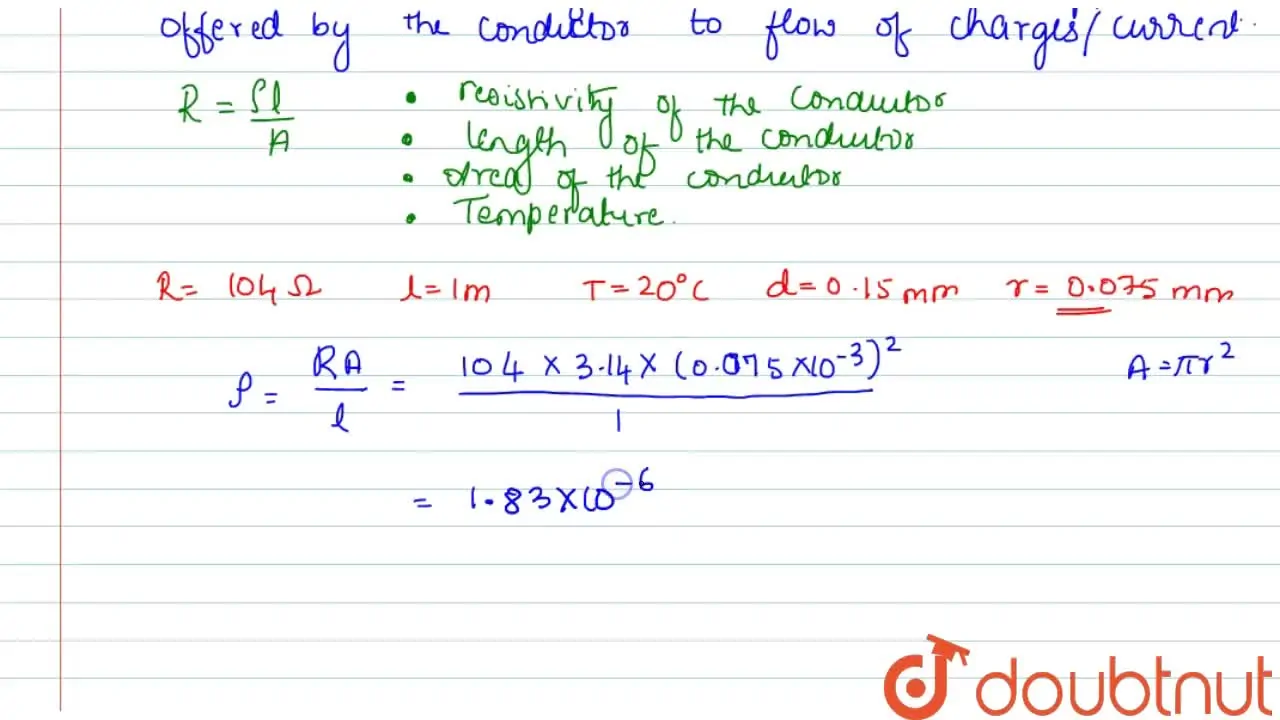a] Define electric resistance of a conductor.
b] List the factors on which resistance of a conductor depends.
c] Resistance of a metal wire of length 1 m is . If the diameter of the wire is 0.15 mm, find the resistivity of the metal at this temperature.Solution in Kannada
a] Resistance is defined as the property of a conductor to resist the flow of charges through it. The resistance of conductor is numerically given as the ratio of potential difference across its length to the current flowing through it.
b] There are four factors that influence the resistance in a conductor.
Thickness [cross sectional area of the wire], length, temperature and resistivity of the material that is used. Some metals [copper, silver] have lower resistivity than others [iron, aluminum].
c] Resistance,
Length of wire, L = 1 m
Diameter of wire, d = 0.15 mm =
Cross-sectional area of wire,
=
Hence, resistivity is
Related Playlists
- BOOK - ZEN PUBLICATIONCHAPTER - ELECTRICITYEXERCISE - ZEN ADDITIONAL QUESTIONS SECTION (MULTIPLE CHOICE QUESTIONS)60videos
ELECTRICITY
- BOOK - ZEN PUBLICATIONCHAPTER - ELECTRICITYEXERCISE - ZEN ADDITIONAL QUESTIONS SECTION (SHORT ANSWER TYPE 2 QUESTIONS)24videos
ELECTRICITY
- BOOK - ZEN PUBLICATIONCHAPTER - LIGHT - REFLECTION AND REFRACTIONEXERCISE - ZEN ADDITIONAL QUESTIONS SECTION (LONG ANSWER [LA] QUESTIONS)30videos
LIGHT - REFLECTION AND REFRACTION
Similar Questions
A cell, a resistor, a key and ammeter are arranged as shown in the circuit diagrams. The current recorded in the ammeter will be
 03:50View Solution
03:50View SolutionThree 2Ω resistors, A, B and C, are connected as shown in figure. Each of them dissipates energy and can withstand a maximum power of 18 W without melting. Find the maximum current that can flow through the three resistors?
 04:26View Solution
04:26View SolutionDraw ray diagrams showing the image formation by a concave mirror when an object is placed.
(a) between pole and focus of the mirror
(b) between focus and centre of curvature of the mirror
(c ) at centre of curvature of the mirror
(d) a little beyond centre of curvature of the mirror
(e ) at infinity03:41View SolutionResistance of a metal wire of length 1 m is 26Ω at 20∘C. If the diameter of the wire is 0.3mm, what will be the resistivity of the metal at that temperature ? Using Table 1.1, predict the material of the wire.
03:38View Solution20∘C पर किसी धातु के 1.1 m लम्बे तार का प्रतिरोध 28Ω है । यदि तार का व्यास 0.3 mm है , तो इस ताप पर धातु की प्रतिरोधकता क्या है ?
03:59View SolutionThe resistance R of a conducting wire depends on its material , length l and area of cross section A. The resistivity of the material of the wire is ρ=(RA)l the value of ρ is for different materials .It is very low for conducting materials like metals,Besides, the resistance of a conductor also depends on its temperature. IF the resistance of a conductor is R0 at 0∘C and R1 at t∘C, then R1=R0(1+at) where a is called the temperature coefficient of resistance. The resistance increases with temperature for metallic conductors but decreases for graphite,a few metal alloys,and for semiconductors like silicon and germanium.
The resistance of a metal wire increases by 10% when its temperature rises from 10∘C to 110∘C.The temperature coefficient of resistance of the metal is07:14View Solutionकिसी धातु के 1.1m लम्बे तार का 20∘C ताप पर प्रतिरोध 3.5Ω है। यदि तार का व्यास 0.2mm है, तो इस ताप पर धातु की वैद्युत प्रतिरोधकता ज्ञात कीजिए। प्रतिरोधकता के मान के आधार पर तार की धातु का अनुमान लगाड़ए।
View SolutionResistance of a metal wire of length 1 m is 26 Ω at 20∘C. If the diameter of the wire is 0.3 mm, what will be the resistivity of the metal at that temperature? Using Table 12.2, predict the material of the wire.
03:16View SolutionDefine resistance of a conductor and its cause. Explain the factors on which its value depends. How will the resistance of a wire of metal be affected if its temperature is changed?
03:01View SolutionDefine electric resistance of a conductor?
(b) List two factors on which resistance of a conductor depends.
(c ) Resistance of a metal wire of length 1m is 104Ω at 20∘C. IF the diameter of the wire is 0.15mm, find the resistivity of the metal at that temperature.02:27View SolutionResistance of a metal wire of length 1 m is 26 Omega at 20^@ C . If the diameter of the wire is 0.3 mm , what will be the resistivity of the metal at that temperature ? .
02:50View Solutiona] Define electric resistance of a conductor. b] List the factors on which resistance of a conductor depends. c] Resistance of a metal wire of length 1 m is 104Omega" at "20^(@)C . If the diameter of the wire is 0.15 mm, find the resistivity of the metal at this temperature.
01:47View SolutionWhat is resistance of a wire ? What are the factors on which resistance of a conductor depends?
View SolutionResistance of a metal of length 1 m is 26 Omega at 20^@C If the diameter of the wire is 0-3mm What will be the resistivity of the metal at that temperature?Using standard table of resistivity of various metals,predict the material of the wire.
03:03View SolutionThe resistance of a metal wire of length 1m is 3 ohm. The diameter of the wire is 0.2 m. Calculate the resistivity of the metal at the temperature.
02:21View Solution


